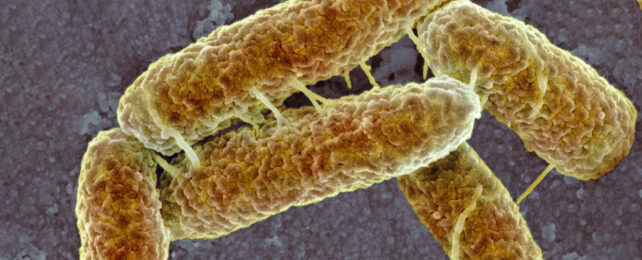Bacteria can develop a heightened new sensitivity to acid levels when exposed to different environmental extremes in the laboratory, a new study shows.
This sense triggers a cascade of different gene expression, allowing the microbes to reconfigure themselves to the constantly changing extremes.
From the smallest cells to the largest whales, all life faces the challenge of ever-shifting and cycling environmental conditions.
To better understand how we can physiologically bend to such extremes, microbiologist Sarah Worthan from Vanderbilt University in Nashville and her team pushed Escherichia coli bacteria to the extreme.
Some of the bacteria populations were able to quickly evolve genetic mutations that helped them thrive. Cancers make use of the resulting mutations too, to create themselves a more favorable environment.
"Our results suggest [these mutations] may serve to rapidly coordinate complex physiological responses through pH sensing and shed light on how cellular populations use environmental cues to coordinate rapid responses to complex, fluctuating environments," the researchers write in their paper.
Worthan and colleagues created their intense experimental version of environmental shifts by exposing 16 populations of E. coli to bouts of extreme, long-term starvation before transferring them into a fresh nutrient-rich environment and repeating the process.
As the microbes starved, metabolic waste accumulated, causing drastic changes in their environmental pH. The bacteria were then given a fresh start with new resources every 100 days, replicating the feast and famine cycle life often faces in the real world.
A single protein building block change sprung up and spread in seven of the bacteria populations, mostly within only the first 300 days of the experiment. This amino acid change from an arginine to a histidine happened in the Rho protein – a molecule involved in telling the bacteria's protein-making machinery when to cease production.
"This mutation in rho repeatedly arose in our laboratory evolution cultures," explains Vanderbilt University microbiologist Megan Behringer.
"We returned to our genomic data and noticed that every mutation in rho co-occurred with a mutation in a gene named 'ydcI.' Not much is known about this gene, but very recent studies suggested that it may have a role in pH homeostasis."
The normal Rho protein helps the bacteria cells to do better in feast condition, but is a hindrance when its owner faces famine. Worthan and team found mutated ydcI allowed cells to better tolerate changes in the Rho protein.
The ydcI mutation appears to be responding to changes in pH. So it acts as a switch turned on by changes in the environment to trigger changes within individual cells.
"Even though bacteria interact with each other through their extracellular environment, individual cells have some control over their intracellular environments," says Bratton.
These genes work together to allow the cells to more easily bend physiologically to the constantly shifting environmental conditions. The team found several examples of the same mechanism in nature.
"We found it in this neglected pathogen, Bartonella bacilliformis, which causes Carrion's Disease in the Andean valleys of South America," says Behringer.
"This species of bacteria was already known to pH sense as it must rapidly adjust from the high pH insect gut to the neutral pH of human blood when it's transmitted by its sand fly vector."
Being good at adapting like this helps cells outcompete others, as we see with cancer. Cancers appear to make use of a similar mechanism to increase their internal pH too, creating a cascade of different gene expression that are then used to reshape the cellular environment around them.
These results illustrate "the power of experimental evolution for identifying functionally important mutations relevant to natural environments," Worthan and team conclude.
This research was published in PNAS.
